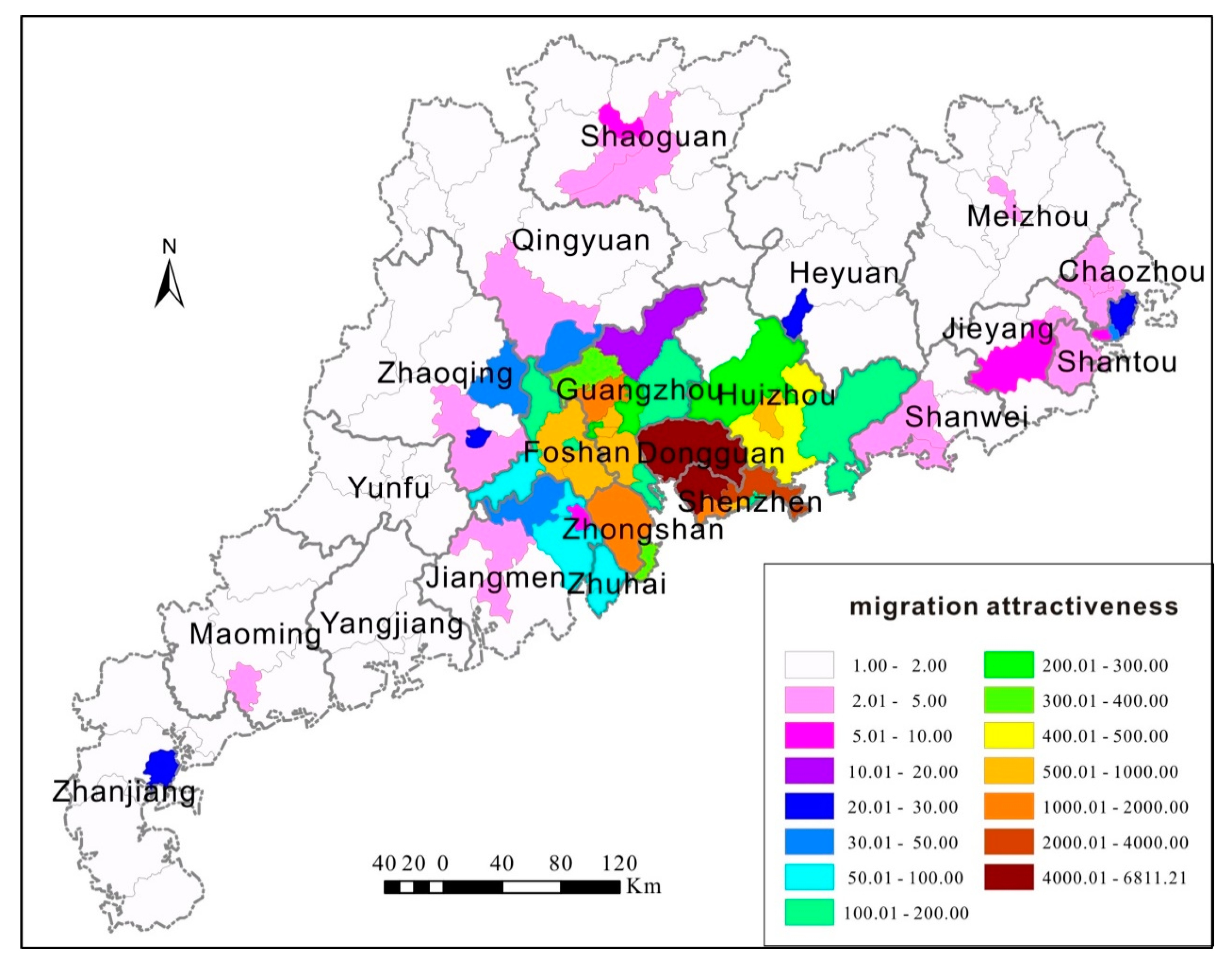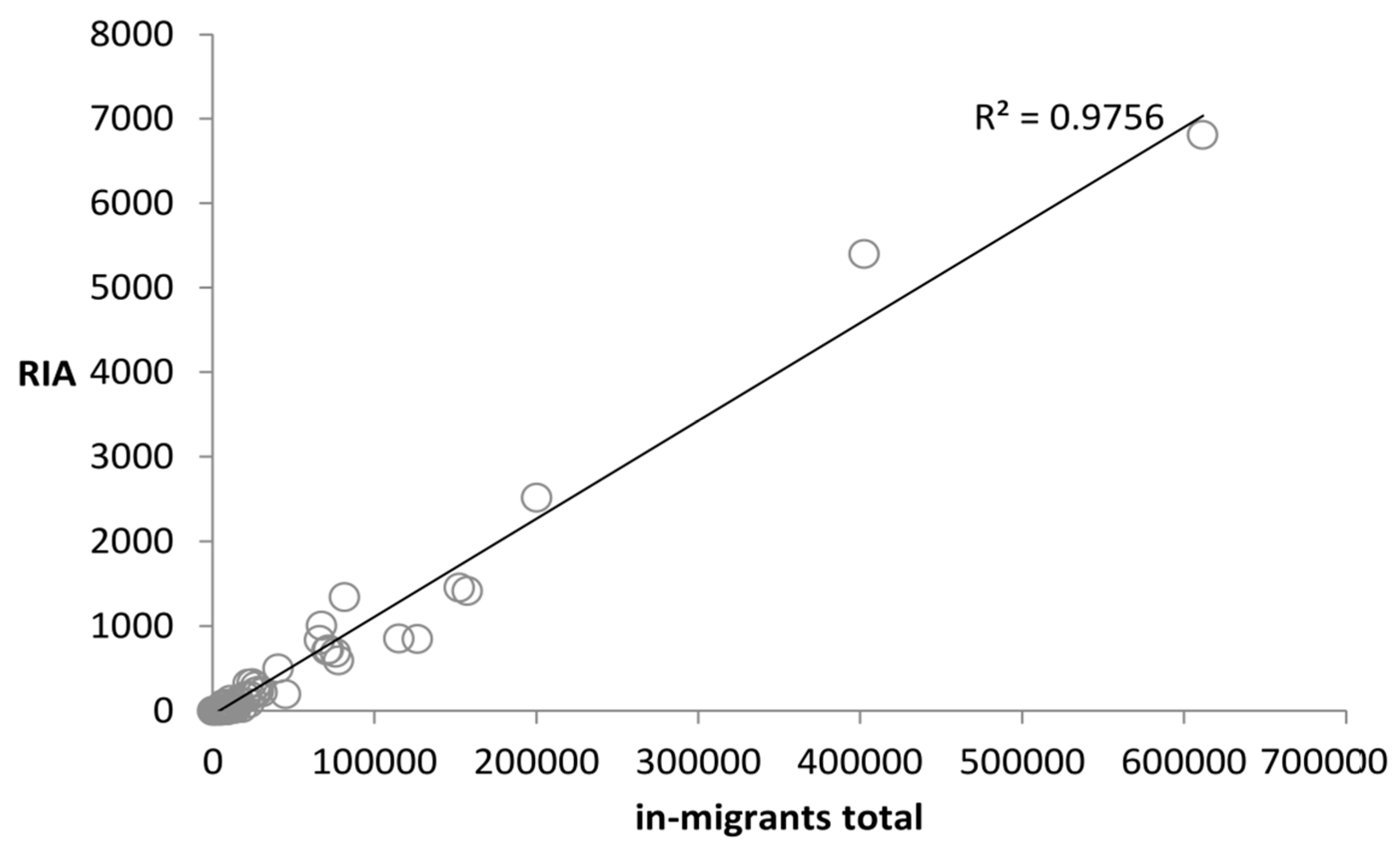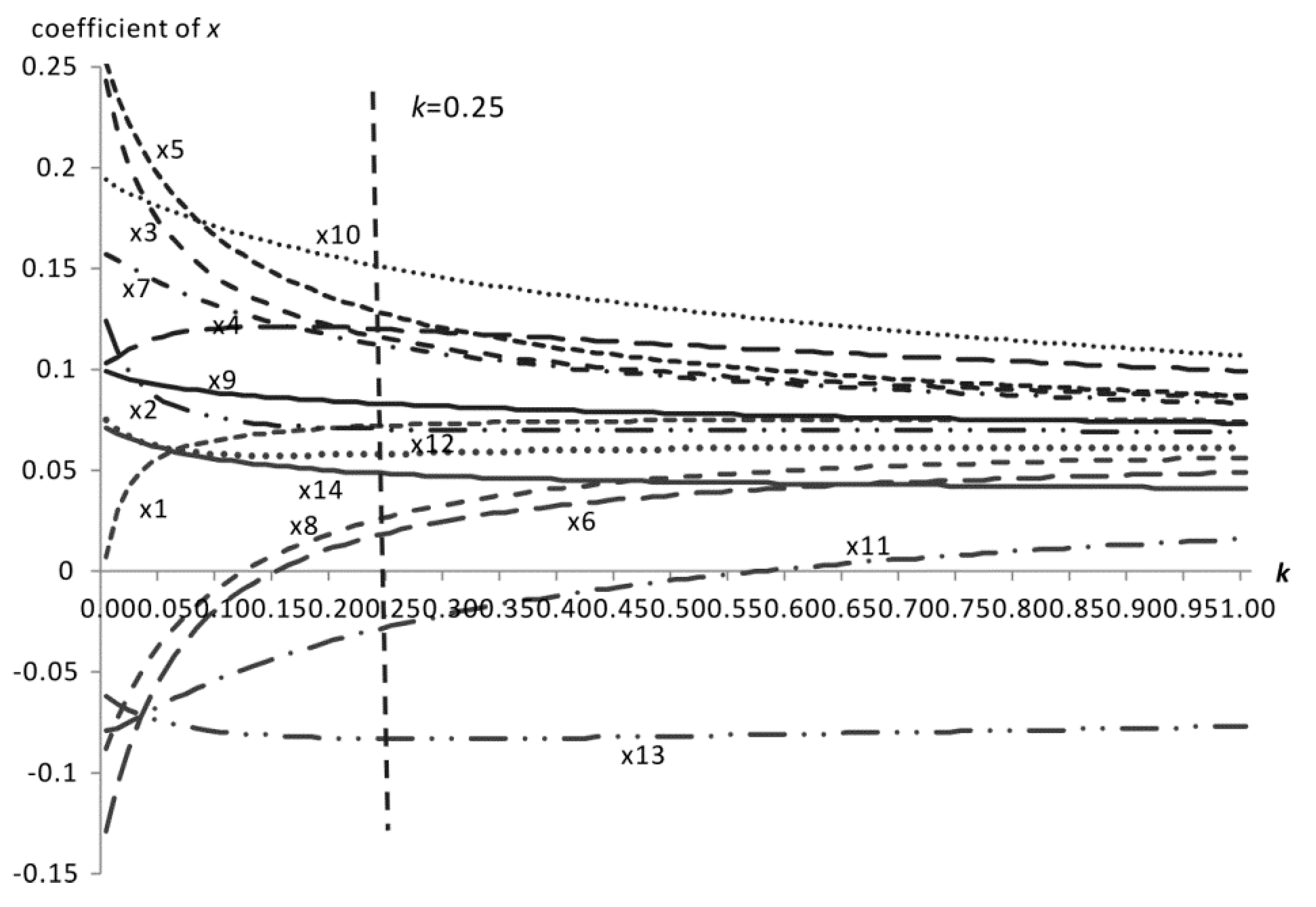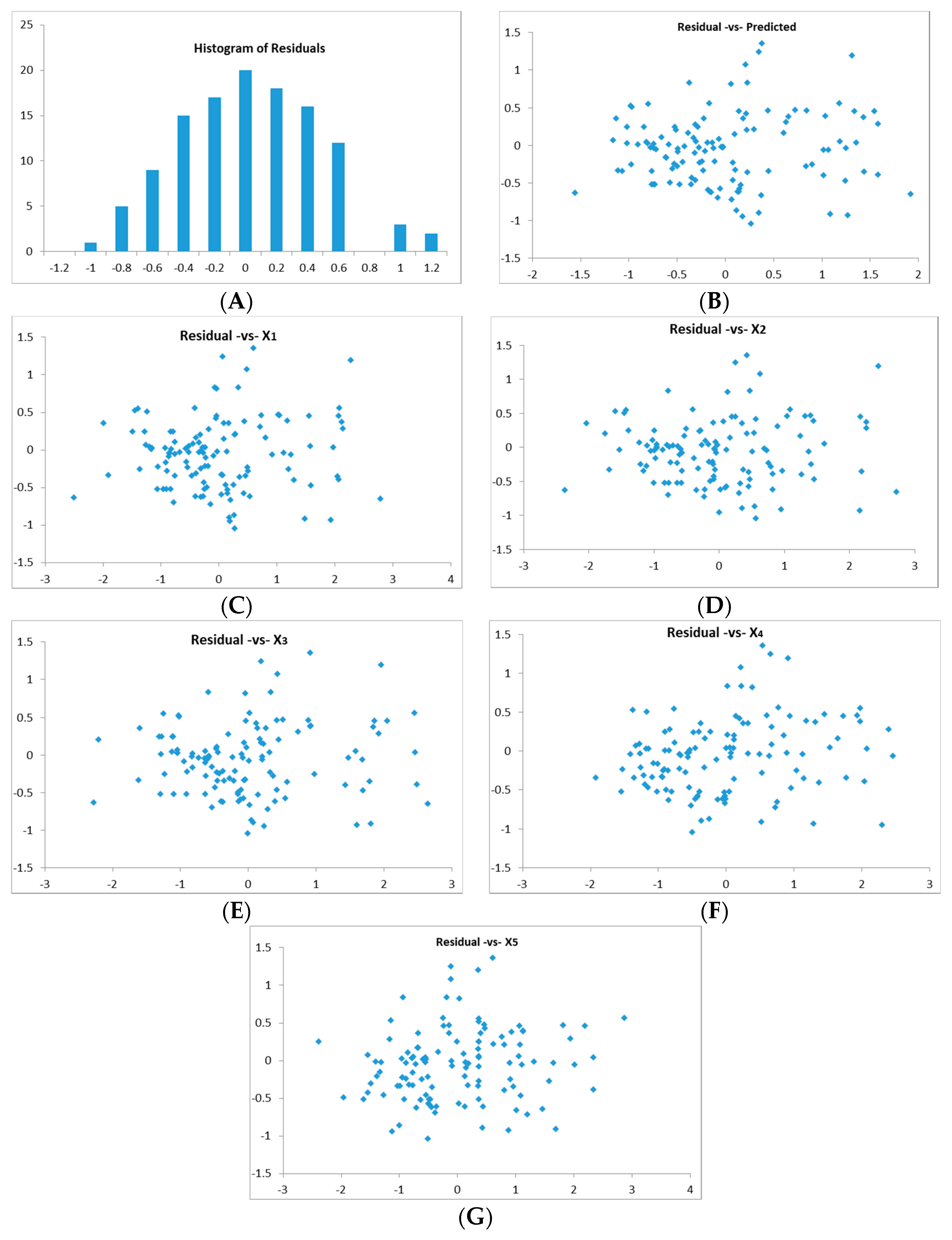County-Scale Destination Migration Attractivity Measurement and Determinants Analysis: A Case Study of Guangdong Province, China
Abstract
:1. Introduction
2. Study Area, Materials and Methods
2.1. Study Area
2.2. Materials
2.2.1. Migration Data
2.2.2. Migration Distance
2.2.3. Migration Determinants
2.3. Methods
2.3.1. Destination Attractivity Measurement
2.3.2. Attractivity Spatial Difference Measurement—Global Spatial Autocorrelation
2.3.3. Attractivity Spatial Difference Measurement Method—Local Spatial Autocorrelation (LISA)
2.3.4. Determinants Analysis
3. Results
3.1. RIA Measurement
3.2. RIA Spatial Difference
3.3. Determinants Analysis
3.3.1. Determinants of Economic Development
3.3.2. Determinants of Social Service and Living Standards
3.3.3. Determinants of Population Quality
4. Conclusions and Discussion
Author Contributions
Funding
Acknowledgments
Conflicts of Interest
References
- Parrado, E.; Kandel, W. Industrial change, his-panic immigration and the internal migration of low-skilled native male workers in the united states, 1995–2000. Soc. Sci. Res. 2011, 40, 626–640. [Google Scholar] [CrossRef]
- Fielding, A. The impacts of environmental change on UK internal migration. Glob. Environ. Chang. 2011, 21S, S121–S130. [Google Scholar] [CrossRef]
- Yormirzoev, M. Determinants of labor migration flows to Russia: Evidence from Tajikistan. Econ. Sociol. 2017, 10, 72–80. [Google Scholar] [CrossRef] [PubMed]
- Asheim, B.; Hansen, H.K. Knowledge bases, talents and contexts: On the usefulness of the creative class approach in Sweden. Econ. Geogr. 2009, 85, 425–442. [Google Scholar] [CrossRef]
- Hansen, H.K.; Niedomysl, T. Migration of the creative class: Evidence from Sweden. J. Econ. Geogr. 2009, 9, 191–206. [Google Scholar] [CrossRef]
- Gallemore, C.; Munroe, D.; van Berkel, D. Rural-to-urban migration and the geography of absentee non-industrial private forest ownership: A case from Southeast Ohio. Appl. Geogr. 2018, 96, 141–152. [Google Scholar] [CrossRef]
- United Nations; Department of Economic and Social Affairs; Population Division. Trends in International Migrant Stock: The 2017 Revision. 2017. (United Nations Database, pop/db/mig/stock/rev.2017). Available online: http://www.un.org/en/development/desa/population/migration/data/estimates2/docs/MigrationStockDocumentation_2017.pdf (accessed on 1 January 2019).
- Shen, J.F.; Xu, W. Migration and development in China: Introduction. China Rev. Interdiscipl. J. Greater China 2016, 16, 1–7. [Google Scholar]
- Shen, J.F. Increasing internal migration in China from 1985 to 2005: Institutional versus economic drivers. Habitat Int. 2013, 39, 1–7. [Google Scholar] [CrossRef]
- Liu, S.H.; Hu, Z.; Deng, Y. The regional types of China’s floating population: Identification methodsand spatial patterns. J. Geogr. Sci. 2011, 21, 35–48. [Google Scholar] [CrossRef]
- National Health and Family Planning Commission of China. Report on China’s Migrant Population Development; China Population Publishing House: Beijing, China, 2016. [Google Scholar]
- Chen, Y.F.; Wang, J.Y.; Liu, Y.S. Regional suitability for settling rural migrants in urban China. J. Geogr. Sci. 2013, 23, 1136–1152. [Google Scholar] [CrossRef]
- Fan, C.C. Interprovincial migration, population redistribution and regional development in China: 1990 and 2000 census comparisons. Prof. Geogr. 2005, 57, 295–311. [Google Scholar] [CrossRef]
- Wu, H.X.Y. Rural to urban migration in the Peoples-Republic-of-China. China Q. 1994, 139, 669–698. [Google Scholar] [CrossRef]
- Chan, K.W. Migration and development in China: Trends, geography and current issues. Migr. Dev. 2012, 1, 187–205. [Google Scholar] [CrossRef]
- Chan, K.W.; Zhang, L. The Hukou system and rural-urban migration in China: Processes and changes. China Q. 1999, 160, 818–855. [Google Scholar] [CrossRef]
- Bai, N.S.; Li, J. China’s urbanization and rural labor migration. Chin. J. Popul. Sci. 2008, 4, 2–10. (In Chinese) [Google Scholar]
- Tapp, N. Miao migrants to Shanghai: Multilocality, in-visibility and ethnicity. Asia Pac. Viewp. 2014, 55, 381–399. [Google Scholar] [CrossRef]
- Liu, Y.; Shen, J.F. Spatial patterns and determinants of skilled internal migration in China, 2000–2005. Pap. Reg. Sci. 2014, 93, 749–771. [Google Scholar] [CrossRef]
- Qiao, X.C.; Huang, Y.H. Floating populationacross provinces in China: Analysis based on the sixthcensus. Popul. Dev. 2013, 19, 13–28. (In Chinese) [Google Scholar]
- Duan, C.R.; Yang, G.; Zhang, F. Nine trends of the changes of China’s floating population since the reformand opening-up. Popul. Res. 2008, 32, 30–43. (In Chinese) [Google Scholar]
- Liu, Y.; Stillwell, J.; Shen, J.F.; Daras, K. Interprovincial migration, regional development and state policy in China, 1985–2010. Appl. Spat. Anal. Policy 2014, 7, 47–70. [Google Scholar] [CrossRef]
- Wang, C. Place of desire: Skilled migration frommainland China to post-colonial Hong Kong. Asia Pac. Viewp. 2013, 54, 388–397. [Google Scholar] [CrossRef]
- Sun, M.J.; Fan, C.C. China’s permanent and tem-porary migrants: Differentials and changes, 1990–2000. Prof. Geogr. 2011, 63, 92–112. [Google Scholar] [CrossRef]
- Li, H.S.; Wang, Y.J.; Han, J.F. Origin distribution visualization of floating population and determinants analysis: A case study of Yiwu city. Proced. Environ. Sci. 2011, 7, 116–121. [Google Scholar] [CrossRef]
- Fan, C.C. China on the Move: Migration, the State, and the Household; Routledge: London, UK; New York, NY, USA, 2008. [Google Scholar]
- Wang, F.; Zuo, X.; Ruan, D. Rural migrants in Shanghai: Living under the shadow of socialism. Int. Migr. Rev. 2002, 36, 520–545. [Google Scholar]
- Liu, Y.; Shen, J.F.; Xu, W.; Wang, G.X. From school to university to work: Migration of highly educated youths in China. Ann. Reg. Sci. 2017, 59, 651–676. [Google Scholar] [CrossRef]
- Liu, Y.; Shen, J.F. Modelling skilled and less-skilled interregional migrations in China, 2000–2005. Popul. Space Place 2017, 23. [Google Scholar] [CrossRef]
- Zhu, Y.; Ding, J.H.; Wang, G.X.; Shen, J.F.; Lin, L.Y.; Ke, W.Q. Population geography in China since the 1980s: Forging the links between population studies and human geography. J. Geogr. Sci. 2016, 26, 1133–1158. [Google Scholar] [CrossRef]
- Shen, J.F.; Liu, Y. Skilled and less-skilled interregional migration in China: A comparative analysis of spatial patterns and the decision to migrate in 2000–2005. Habitat Int. 2016, 57, 1–10. [Google Scholar] [CrossRef]
- Fotheringham, A.S.; Champion, T.; Wymer, C.; Coombes, M. Measuring destination attractivity: A migration example. Int. J. Popul. Geogr. 2000, 6, 391–421. [Google Scholar] [CrossRef]
- Qiao, L.Y.; Li, Y.R.; Liu, Y.S.; Yang, R. The spatio-temporal change of China’s net floating population at county scale from 2000 to 2010. Asia Pac. Viewp. 2016, 57, 365–378. [Google Scholar] [CrossRef]
- Zhou, J. The new urbanisation plan and permanent urban settlement of migrants in Chongqing, China. Popul. Space Place 2018, 24. [Google Scholar] [CrossRef]
- Hao, P.; Tang, S.S. Migration destinations in the urban hierarchy in China: Evidence from Jiangsu. Popul. Space Place 2018, 24. [Google Scholar] [CrossRef]
- Fan, X.M.; Liu, H.G.; Zhang, Z.M.; Zhang, J. The spatio-temporal characteristics and modeling research of inter-provincial migration in China. Sustainability 2018, 10, 618. [Google Scholar] [CrossRef]
- Cheng, Y.; Lv, Y.X.; Rosenberg, M.; Hou, L.K. Decision making of non-agricultural work by rural residents in Weifang, China. Sustainability 2018, 10, 1647. [Google Scholar] [CrossRef]
- Amara, M.; Jemmali, H. Deciphering the relationship between internal migration and regional disparities in tunisia. Soc. Indic. Res. 2018, 135, 313–331. [Google Scholar] [CrossRef]
- Tan, S.K.; Li, Y.A.; Song, Y.; Luo, X.; Zhou, M.; Zhang, L.; Kuang, B. Influence factors on settlement intention for floating population in urban area: A China study. Qual. Quant. 2017, 51, 147–176. [Google Scholar] [CrossRef]
- Wang, L.; Wang, J.F.; Xu, C.D.; Liu, T.J. Modelling input-output flows of severe acute respiratory syndrome in mainland China. BMC Public Health 2016, 16, 191. [Google Scholar] [CrossRef]
- Kalogirou, S. Destination choice of athenians: An application of geographically weighted versions of standard and zero inflated poisson spatial interaction models. Geogr. Anal. 2016, 48, 191–230. [Google Scholar] [CrossRef]
- Chen, S.W.; Liu, Z.L. What determines the settlement intention of rural migrants in China? Economic incentives versus sociocultural conditions. Habitat Int. 2016, 58, 42–50. [Google Scholar] [CrossRef]
- Jivraj, S.; Brown, M.; Finney, N. Modelling spatial variation in the determinants of neighbourhood family migration in england with geographically weighted regression. Appl. Spat. Anal. Policy 2013, 6, 285–304. [Google Scholar] [CrossRef]
- Li, W.J.; Holm, E.; Lindgren, U. Attractive vicinities. Popul. Space Place 2009, 15, 1–18. [Google Scholar] [CrossRef]
- Delisle, F.; Shearmur, R. Where does all the talent flow? Migration of young graduates and nongraduates, canada 1996–2001. Can. Geogr.-Geogr. Can. 2010, 54, 305–323. [Google Scholar] [CrossRef]
- Niedomysl, T.; Hansen, H.K. What matters more for the decision to move: Jobs versus amenities. Environ. Plan. A 2010, 42, 1636–1649. [Google Scholar] [CrossRef]
- Gries, T.; Kraft, M.; Simon, M. Explaining inter-provincial migration in China. Pap. Reg. Sci. 2016, 95, 709. [Google Scholar] [CrossRef]
- Cliff, A.; Ord, J. Spatial Autocorrelation; Pion: London, UK, 1973. [Google Scholar]
- Anselin, L. Local indicators of spatial association–lisa. Geogr. Anal. 1995, 27, 93–115. [Google Scholar] [CrossRef]
- Thomas, M.; Stillwell, J.; Gould, M. Modelling multilevel variations in distance moved between origins and destinations in England and Wales. Environ. Plan. A 2015, 47, 996–1014. [Google Scholar] [CrossRef]
- Hoerl, A.E.; Kennard, R.W. Ridge regression: Biased estimation for nonorthogonal problems. Technometrics 1970, 12, 55–67. [Google Scholar] [CrossRef]
- Khalaf, G.; Shukur, G. Choosing ridge parameter for regression problems. Commun. Stat.-Theory Methods 2005, 34, 1177–1182. [Google Scholar] [CrossRef]
- Hoerl, A.E.; Kennard, R.W. Ridge regression: Biased estimation for nonorthogonal problems. Technometrics 2000, 42, 80–86. [Google Scholar] [CrossRef]
- Lecessie, S.; Vanhouwelingen, J.C. Ridge estimators in logistic-regression. Appl. Stat.-J. R. Stat. Soc. Ser. C 1992, 41, 191–201. [Google Scholar]
- Casella, G. Minimax ridge-regression estimation. Ann. Stat. 1980, 8, 1036–1056. [Google Scholar] [CrossRef]
- Marquardt, D.W.; Snee, R.D. Ridge regression in practice. Am. Stat. 1975, 29, 3–20. [Google Scholar]
- Hoerl, A.E.; Kennard, R.W.; Baldwin, K.F. Ridge regression–some simulations. Commun. Stat. 1975, 4, 105–123. [Google Scholar] [CrossRef]
- Vigneau, E.; Devaux, M.F.; Qannari, E.M.; Robert, P. Principal component regression, ridge regression and ridge principal component regression in spectroscopy calibration. J. Chemom. 1997, 11, 239–249. [Google Scholar] [CrossRef]
- Shen, J.F.; Wang, L. Urban competitiveness and migration in the yrd and prd regions of China in 2010. China Rev. Interdiscipl. J. Greater China 2016, 16, 149–174. [Google Scholar]
- Shen, J.F. Explaining interregional migration changes in China, 1985–2000, using a decomposition approach. Reg. Stud. 2015, 49, 1176–1192. [Google Scholar] [CrossRef]






| Factors | Variables |
|---|---|
| Economics factors | GDP (x1) |
| Secondary Industrial Output Value (x2) | |
| Tertiary Industrial Output Value (x3) | |
| Per Capital Gross Domestic Product (x4) | |
| Total Investment in Fixed Assets (x5) | |
| Total Retail Sales of Consumer Goods (x6) | |
| the number of industrial enterprises above designated size (x7) | |
| the industrial output value of industrial enterprises above the designated size (x8) | |
| Social service and living standard | the Savings Deposits by Urban and Rural Residents (x9) |
| the Annual Average Wage of Fully Employed Staff and Workers (x10) | |
| the Number of Hospital Beds (x11) | |
| Destination population level | Mean Years of Schooling (x12) |
| Adult illiteracy Rate, Population 15+ years both Sexes (x13) | |
| Labor Force Participation Rate (x14) |
| County | Dongguan | Baoan | Longgang | Baiyun | Zhonshan |
|---|---|---|---|---|---|
| RIA | 6811 | 5400 | 2515 | 1452 | 1417 |
| County | Futian | Nanshan | Shunde | Nanhai | Luohu |
| RIA | 1339 | 1002 | 853 | 847 | 838 |
| County | Tianhe | Huicheng | Panyu | Haizhu | Huiyang |
| RIA | 726 | 715 | 683 | 593 | 496 |
| County | Huadu | Xiangzhou | Yuexiu | Huangpu | Boluo |
| RIA | 322 | 318 | 289 | 233 | 223 |
| County | Liwan | Chancheng | Sanshui | Zengcheng | Luogang |
| RIA | 218 | 194 | 175 | 172 | 163 |
| County | Nansha | Huidong | Yantian | Pengjiang | Xinhui |
| RIA | 130 | 123 | 116 | 89 | 82 |
| Ridge Regression with k = 0.25 | |||||
|---|---|---|---|---|---|
| Mult R | 0.91 | ||||
| RSquare | 0.82 | ||||
| Adj Rsquare | 0.80 | ||||
| SE | 0.45 | ||||
| ANOVA table | |||||
| df | SS | MS | F value | Sig F | |
| Regress | 14 | 98.73 | 7.05 | 35.14 | 0.00 |
| Residual | 106 | 21.27 | 0.20 | ||
| Variables in the Equation | |||||
| B | SE(B) | Beta | T | sig | |
| x1 | 0.0722 | 0.0247 | 0.0722 | 2.9280 | 0.0042 |
| x2 | 0.0705 | 0.0321 | 0.0705 | 2.1973 | 0.0302 |
| x3 | 0.1147 | 0.0335 | 0.1147 | 3.4272 | 0.0009 |
| x4 | 0.1197 | 0.0367 | 0.1197 | 3.2651 | 0.0015 |
| x5 | 0.1266 | 0.0376 | 0.1266 | 3.3687 | 0.0011 |
| x6 | 0.0194 | 0.0336 | 0.0194 | 0.5756 | 0.5661 |
| x7 | 0.1114 | 0.0377 | 0.1114 | 2.9588 | 0.0038 |
| x8 | 0.0272 | 0.0351 | 0.0272 | 0.7753 | 0.4399 |
| x9 | 0.0829 | 0.0375 | 0.0829 | 2.2088 | 0.0293 |
| x10 | 0.1501 | 0.0364 | 0.1501 | 4.1229 | 0.0001 |
| x11 | −0.0274 | 0.0371 | −0.0274 | −0.7378 | 0.4623 |
| x12 | 0.0582 | 0.0357 | 0.0582 | 1.6304 | 0.1060 |
| x13 | −0.0831 | 0.0374 | −0.0831 | −2.2229 | 0.0283 |
| x14 | 0.0482 | 0.0346 | 0.0482 | 1.3944 | 0.1661 |
| Constant | 0.0000 | 0.0407 | 0.0000 | 0.0000 | 1.0000 |
| Ridge Regression with k = 0.25 | |||||
|---|---|---|---|---|---|
| Mult R | 0.91 | ||||
| RSquare | 0.82 | ||||
| Adj Rsquare | 0.81 | ||||
| SE | 0.44 | ||||
| ANOVA table | |||||
| df | SS | MS | F value | Sig F | |
| Regress | 9 | 98.36 | 10.93 | 56.06 | 0.00 |
| Residual | 111 | 21.64 | 0.20 | ||
| Variables in the Equation | |||||
| B | SE(B) | Beta | T | sig | |
| x1 | 0.0811 | 0.0265 | 0.0811 | 3.0640 | 0.0027 |
| x2 | 0.0822 | 0.0349 | 0.0822 | 2.3573 | 0.0202 |
| x3 | 0.1195 | 0.0340 | 0.1195 | 3.5156 | 0.0006 |
| x4 | 0.1466 | 0.0366 | 0.1466 | 4.0018 | 0.0001 |
| x5 | 0.1184 | 0.0377 | 0.1184 | 3.1379 | 0.0022 |
| x7 | 0.1092 | 0.0368 | 0.1092 | 2.9650 | 0.0037 |
| x9 | 0.0919 | 0.0371 | 0.0919 | 2.4760 | 0.0148 |
| x10 | 0.1567 | 0.0356 | 0.1567 | 4.3991 | 0.0000 |
| x13 | −0.1157 | 0.0375 | −0.1157 | −3.0885 | 0.0025 |
| Constant | 0.0000 | 0.0401 | 0.0000 | 0.0000 | 1.0000 |
© 2019 by the authors. Licensee MDPI, Basel, Switzerland. This article is an open access article distributed under the terms and conditions of the Creative Commons Attribution (CC BY) license (http://creativecommons.org/licenses/by/4.0/).
Share and Cite
Yang, Q.; Zhang, H.; M Mwenda, K. County-Scale Destination Migration Attractivity Measurement and Determinants Analysis: A Case Study of Guangdong Province, China. Sustainability 2019, 11, 362. https://doi.org/10.3390/su11020362
Yang Q, Zhang H, M Mwenda K. County-Scale Destination Migration Attractivity Measurement and Determinants Analysis: A Case Study of Guangdong Province, China. Sustainability. 2019; 11(2):362. https://doi.org/10.3390/su11020362
Chicago/Turabian StyleYang, Qingsheng, Hongxian Zhang, and Kevin M Mwenda. 2019. "County-Scale Destination Migration Attractivity Measurement and Determinants Analysis: A Case Study of Guangdong Province, China" Sustainability 11, no. 2: 362. https://doi.org/10.3390/su11020362





